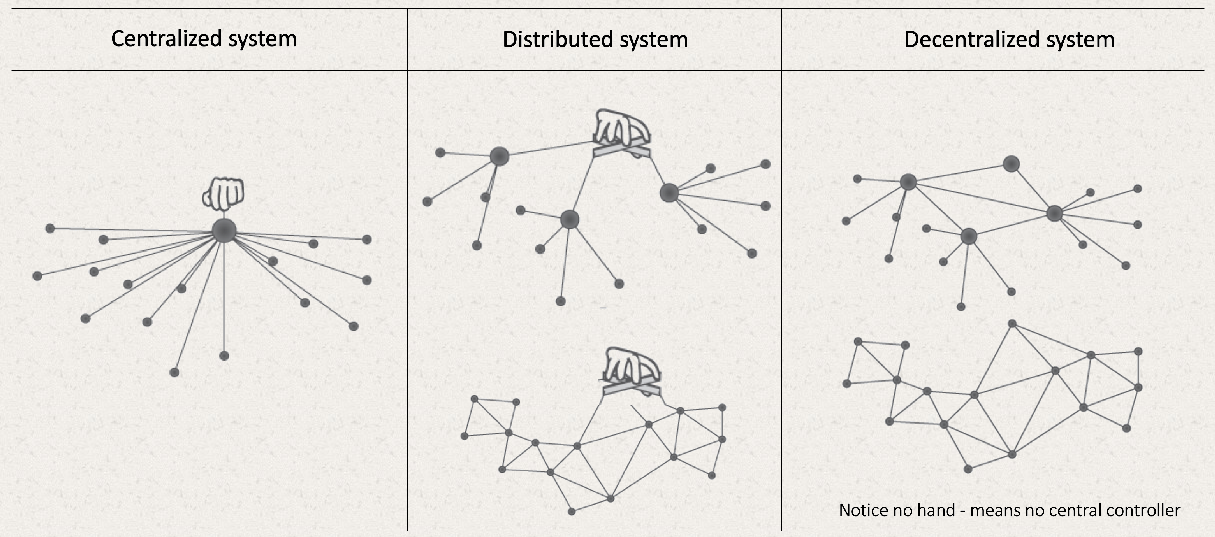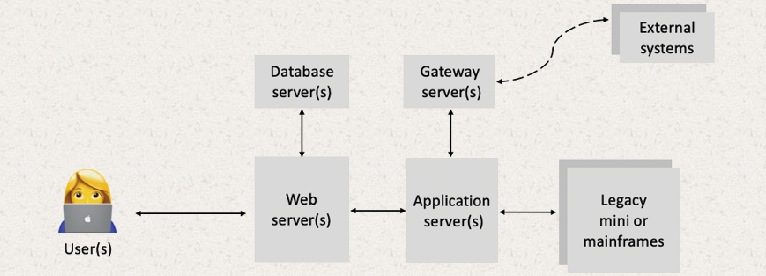The basic idea of decentralization is to distribute control and authority to the peripheries of an organization instead of a central body having total control over it.
Decentralization is seen as a way to improve efficiency and democracy in organizations, as it allows decision making closer to the interests and needs of the different parties involved. In addition, decentralization can help reduce corruption and bureaucracy by avoiding the concentration of power in one place. In blockchain technology, decentralization is used to create distributed, trustless systems that allow for reliable transactions and contracts without the need for intermediaries.
Decentralization using Blockchain
Traditionally, Information and Communication Technologies (ICT) were based on a central system, where an administrator was responsible for storing and distributing information to the network. With the advent of Bitcoin, a new model opens up, where a network of independent users can connect and exchange information without any authority figure directing the system.
This new paradigm can serve both to generate new decentralized systems and to remodel and decentralize existing traditional communication systems.
In addition, this decentralization in ICT allows for greater security and privacy of information, since it does not depend on a single point of failure or central control. It also allows greater resistance to attacks and the possibility of recovery in the event of network failures, thanks to the redundancy of data stored in different nodes. It also offers greater transparency and participation in decision-making, since any user can participate in the network and contribute solutions. In short, decentralization has enabled the creation of more democratic, secure and resilient systems.
Types of systems
Paul Baran, in the memorandum entitled “On Distributed Communications: Introduction to Distributed Communications Networks“, which gathers ideas on the subject of distributed communications in information and communication technologies, classifies systems according to their topology, distinguishing three types:
- Centralized: All information is stored in a single authority (server) that is in charge of system operations and distributes the information among the rest of the nodes (clients). It is the paradigm of a traditional information system. This type of system is commonly used in online applications and services that require a central authority to control and manage the information and processes of the client nodes. However, their dependence on a single server can be a weakness in terms of reliability and security.
- Distributed: Information is spread across multiple nodes, although there is still a central authority to manage that data. Although several servers process information, all of them are managed by the same agent. This type of system is characterized by the distribution of information and processes among several nodes, which makes them more resistant to failures and attacks. Parallel and non-parallel systems have different approaches to handling information and processes, and each has its own advantages and disadvantages.
- Parallel system: All nodes perform computations simultaneously to obtain a single result. This type of systems are suitable for tasks that require a large amount of processing power and are characterized by the simultaneous performance of computations on several nodes to obtain a single result. Specifically, they are commonly used in data analysis and scientific applications.
- Non-parallel system: Data is replicated on several nodes that users see as a single, coherent system. This type of systems are based on data replication in several nodes and are used to ensure information availability and process continuity in case of failures in one or more nodes. These systems are suitable for online applications that require high availability and data consistency.
- Decentralized: The system is not dependent on a master node, but control is distributed among many nodes. This type of system is characterized by the lack of dependence on a central authority and the distribution of control and decision making among many nodes. These systems are used in applications that require transparency, security and privacy, such as blockchain-based systems. By not relying on a central node, these systems are more resilient to failures and attacks and provide a higher level of security and privacy for users and their data.El sistema no es dependiente de un nodo maestro, sino que el control está distribuido entre muchos nodos. Este tipo de sistemas se caracteriza por la falta de dependencia en una autoridad central y la distribución del control y la toma de decisiones entre muchos nodos. Estos sistemas son usados en aplicaciones que requieren transparencia, seguridad y privacidad, como los sistemas basados en blockchain. Al no depender de un nodo central, estos sistemas son más resistentes a fallos y ataques y proporcionan un mayor nivel de seguridad y privacidad para los usuarios y sus datos.
Difference between distributed and decentralized system
The following image shows the schema of a distributed system. In a distributed system, the information is divided among multiple nodes, but there is a central authority that supervises and controls the data. In this case, where a client (User) accesses the information stored in different servers through a web server, the information and calculations are distributed among different servers. Each server is dedicated to a specific task and is subordinated to an overall system hierarchy, which functions as a central authority.
On the contrary, the following diagram shows the architecture of a decentralized system. In a decentralized system, there is no master node or central authority that controls the system. Instead, control is distributed among many nodes of equal relevance. This is the case in blockchain-based systems, where several nodes are connected to each other and maintain their own copy of the information, updating each other as information is exchanged. This type of decentralized architecture has the advantage of being much more resilient, since if any node goes offline or fails, the rest of the network can continue to operate independently. In contrast, in a centralized system, a failure in the central server can bring down the entire system.
Decentralization methods
- Disintermediation: Consists in removing the role of intermediary agents that perform or validate a transaction between two parties. For example: to make a money transfer would generally use a bank to validate the transaction, whereas if both participants are on a Blockchain, this bank is no longer necessary and the exchange is done directly. This method achieves a more “pure” decentralization.
- Competition (decentralization by competition): With this other scheme, instead of directly removing the intermediary, different agents compete to be the one offering the mediation service between the two parties. There is still an intermediary in the transaction, but as this is chosen from a number of applicants, the monopoly of an intermediary (such as a bank) is eliminated, thus achieving a certain degree of decentralization.
- Autonomy: This method of decentralization is based on the creation of an infrastructure in which decisions are made by an autonomous algorithm that does not depend on a central or intermediary authority. For example, an automated voting system in which users vote to make decisions in a decentralized organization. This allows decision making to be more democratic and efficient.
- Decentralization by delegation: With this method, users delegate their authority to agents that represent their interests. These agents are responsible for making decisions and taking actions on their behalf. For example, in a proxy voting system, users would delegate their vote to a group of experts who would make decisions on their behalf. Decentralization is achieved by allowing users to delegate their authority to agents representing their interests rather than relying on a central authority.
Degrees of decentralization
There are three degrees of decentralization, each representing a different level of centralization or disintermediation in a system.
- Fully centralized: In this type of system, there is a central authority or intermediary that controls and manages all operations and transactions. This intermediary is responsible for validating and verifying all operations that take place in the system. This is the most common model in traditional systems.
- Semi decentralized: This is an intermediate system between centralization and complete decentralization. In this case, several intermediaries compete with each other to provide services to users and can be chosen by users to perform a particular transaction or operation. In this system, there is a degree of competition and freedom to choose the intermediary, resulting in a degree of decentralization.
- Fully decentralized: In a fully decentralized system, there is no central authority or intermediary to control and validate operations. Instead, transactions and operations are validated by a group of nodes in the network, which means that there is no single point of failure and the network is much more resilient. This is the model of Blockchain-based systems.
Decentralization scheme
The following scheme of questions helps us to identify when we need to use a blockchain, whether it needs to be public or private, or if we really only need a traditional database:
- Are updates controlled centrally?
- Yes: in this case, a traditional database would be the most appropriate option. The database would be controlled by a central authority and changes could only be made through it.
- No: if a more decentralized system is desired, you can opt for a public or private Blockchain. The public Blockchain would be available to all users, while in a private Blockchain, updates could be controlled by a consortium or group of central authorities.
- Do users trust each other?
- Yes: in this case, a traditional database is adequate. These systems rely on users’ good faith and respect for established rules.
- No: if users do not trust each other, a public Blockchain would be an option to consider. The immutability and transparency of the blockchain would ensure that all transactions are recorded and that no user can modify them without being detected.
- Are users anonymous?
- Yes: in this case, a public blockchain is the best option. Users can participate in the network without revealing their real identity, which guarantees the privacy of the information.
- No: if the identity of the users must be known, a private Blockchain would be more suitable. In this case, users would be bound to their transactions and would be subject to regulations and controls.
- Is it necessary to maintain consensus within a consortium?
- Yes: in this case, a private Blockchain would be the most suitable option. The private Blockchain would be controlled by a group of authorized nodes and important decisions would be made by consensus among them.
- No: if there is no need to maintain a specific consensus, a public Blockchain would be the most suitable option. In a public Blockchain, any user can participate and validate transactions, leading to complete decentralization.
Decentralization approach
Before designing the decentralization of a system, it is necessary to carefully assess the objectives and requirements of the system and ask important questions about the type of decentralization to be achieved, the appropriate blockchain technology, the required security mechanisms, and any other relevant factors to ensure an efficient and effective design.
- What is decentralization? Decentralization is a process of eliminating intermediaries and centralizing a system. In blockchain terms, decentralization means that data and transactions are recorded and verified by multiple nodes rather than a central entity. This can include anything from a financial system to a social network.
- What level of decentralization is required? The level of decentralization required depends on the objectives and requirements of the system in question. It can be fully decentralized, where there is no central intermediary, or semi-decentralized, where intermediaries compete with each other to win customers.
- What blockchain is used? There are different types of blockchain, each with its own specific characteristics and uses. For example, a public blockchain is one that is available to anyone, while a private blockchain is one that is limited to a group of authorized nodes. The type of blockchain to use will depend on the security, privacy and scalability requirements of the decentralized system.
- What security mechanism is used? There are different security mechanisms that can be used in a decentralized system. Atomicity refers to the ability to guarantee that a transaction will or will not complete in its entirety. Deterministic refers to the ability to predict the outcome of a transaction based on the input. Reputational refers to the valuation of nodes and their contributions to the network. The security mechanism to be used will depend on the security and privacy requirements of the decentralized system.





